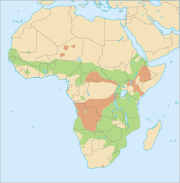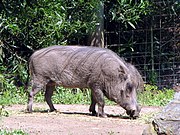
The common warthog is a wild member of the pig family (Suidae) found in grassland, savanna, and woodland in sub-Saharan Africa. In the past, it was commonly treated as a subspecies of P. aethiopicus, but today that scientific name is restricted to the desert warthog of northern Kenya, Somalia, and eastern Ethiopia.
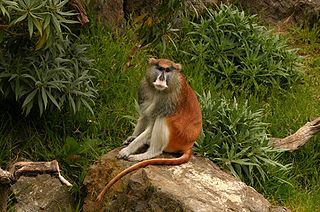
Erythrocebus is a genus of Old World monkey. All three species in this genus are found in Africa, and are known as patas monkeys. While previously considered a monotypic genus containing just E. patas, a 2017 review argued that, based on morphological evidence and heavy geographic separation between taxa, E. patas should be split back into distinct species as recognised in the 19th century.

The needle-clawed bushbabies are the two species in the genus Euoticus, which is in the family Galagidae. Galagidae is sometimes included as a subfamily within the Lorisidae.

The greater galagos or thick-tailed bushbabies are three species of strepsirrhine primates. They are classified in the genus Otolemur in the family Galagidae.

Anomalurus is the largest genus in the rodent family Anomaluridae, with four species. It is the only genus in the subfamily Anomalurinae.
The silver dik-dik is a small antelope found in low, dense thickets along the southeastern coast of Somalia and in Acacia-Commiphora bushland in the Shebelle Valley in southeastern Ethiopia. It is the smallest species of dik-dik, with a length of 45–50 cm (18–20 in), a height of 30–33 cm (12–13 in), and a weight of 2–3 kg (4.4–6.6 lb). Its back and flanks are grizzled silvery, while the limbs, ears, and muzzle are ochraceus in colour. Little is known about its status, but numbers are believed to be decreasing.
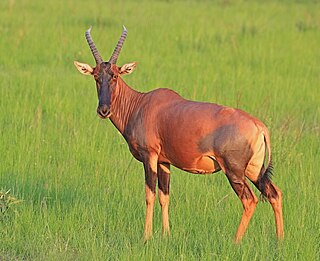
Damaliscus, commonly known as damalisks, is a genus of antelope in the family Bovidae, subfamily Alcelaphinae, found in Africa.
The Western Saharan spiny mouse or Aïr spiny mouse is a species of small, insectivorous rodent in the family Muridae found arid regions of western Africa.
The dune hairy-footed gerbil, or the Namib dune gerbil is a species of rodent found only in Namibia. Its natural habitat is temperate desert where it lives in loose sand among sand dunes, feeding opportunistically on arthropods, seeds and green vegetation.
Lemniscomys linulus, commonly known as the Senegal grass mouse or Senegal one-striped grass mouse, is a species of rodent in the family Muridae. It is found in Ivory Coast, Guinea, Mali, and Senegal and its natural habitat is dry savanna. At one time considered to be a subspecies of Lemniscomys griselda, it is now accepted as a species in its own right.
Mittendorf's lemniscomys or Mittendorf's striped grass mouse is a species of rodent in the family Muridae. It is endemic to Cameroon where it is found at high elevations on a single mountain. Its natural habitat is tropical high-altitude grassland. It faces no particular threats and the International Union for Conservation of Nature has listed it as being of "least concern".

Brants's whistling rat or Brants' whistling rat is one of two species of murid rodent in the genus Parotomys. It is found in Botswana, Namibia, and South Africa where its natural habitats are subtropical or tropical dry shrubland and pastureland. It was first described in 1834 by the Scottish zoologist Andrew Smith who named it in honour of the Dutch zoologist and author Anton Brants.
Boehm's gerbil is a species of rodent found in Angola, Burundi, Democratic Republic of the Congo, Kenya, Malawi, Mozambique, Rwanda, Tanzania, Uganda, and Zambia. Its natural habitats are dry savanna, moist savanna, and arable land. This is a common species with a wide distribution which faces no obvious threats, so in 2004 the International Union for Conservation of Nature rated its conservation status as being of "least concern".

Duthie's golden mole is a species of mammal in the family Chrysochloridae. It is endemic to South Africa. Its natural habitats are subtropical or tropical moist lowland forests, moist savanna, temperate grassland, arable land, pastureland, plantations, rural gardens, and urban area. The specific name duthieae was given in honour of Dr. Augusta Vera Duthie, a South African botanist.
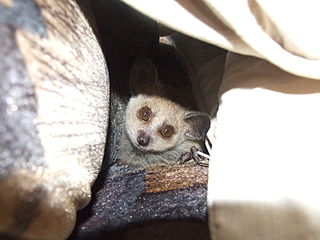
Grant's bushbaby, also known as Grant's lesser bushbaby or the Mozambique lesser bushbaby, is a species of primate in the family Galagidae. It is found in Malawi, Mozambique, Tanzania, and Zimbabwe. Its natural habitat is subtropical or tropical dry forests. It is a common species and the International Union for Conservation of Nature has assessed its conservation status as being of "least concern".

The dusky bushbaby is a species of primate in the family Galagidae. It is also known as Matschie's galago, in honour of the German zoologist Paul Matschie, curator of mammals at the Museum für Naturkunde in Berlin. Native to tropical Central Africa, it is found in forests in Burundi, Rwanda, Democratic Republic of the Congo and Uganda. The species is small with a long tail, and has an arboreal, nocturnal and omnivorous lifestyle.
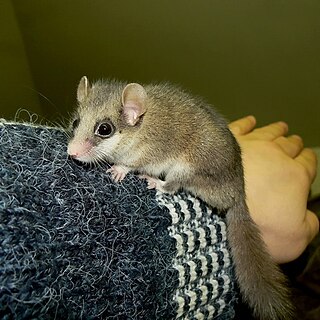
The woodland dormouse is a species of rodent in the family Gliridae. It is native to southern and eastern Africa and is also known as the African dormouse, African dwarf dormouse, African pygmy dormouse, or colloquially as micro squirrel. Found in limited numbers in the pet trade, it has complicated care requirements compared to other pet rodents. Its natural habitats are subtropical or tropical, moist montane forests and rivers.

The desert warthog is a species of even-toed ungulate in the pig family (Suidae), found in northern Kenya and Somalia, and possibly Djibouti, Eritrea, and Ethiopia. This is the range of the extant subspecies, commonly known as the Somali warthog. Another subspecies, commonly known as the Cape warthog, became extinct around 1865, but formerly occurred in South Africa.

The tantalus monkey is an Old World monkey from Africa that ranges from Ghana to Sudan. It was originally described as a subspecies of the grivet. All species in Chlorocebus were formerly in the genus Cercopithecus. It is a common species with a wide range, and the International Union for Conservation of Nature has rated its conservation status as being of "least concern".
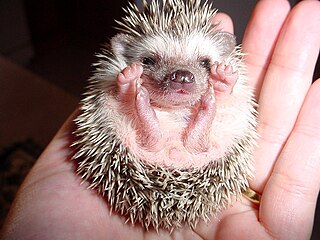
Paraechinus is a genus of hedgehogs. Members are small and nocturnal. The genus contains four species from North Africa, the Middle East and South Asia:



